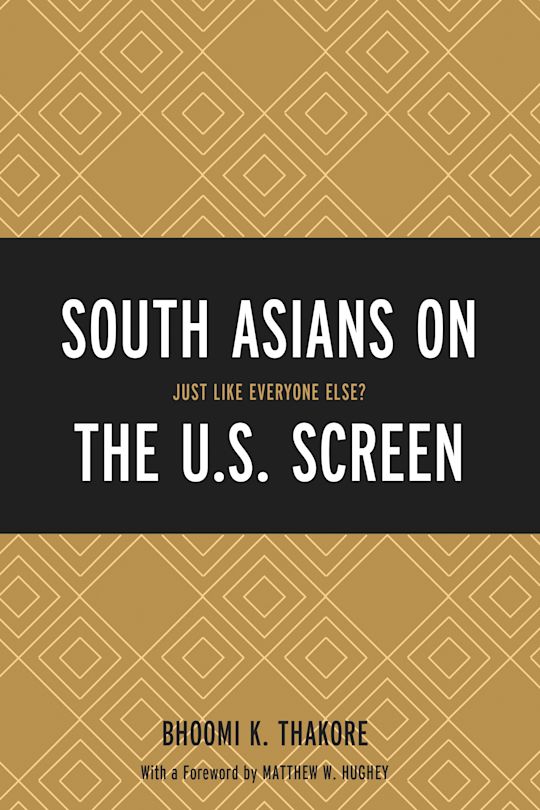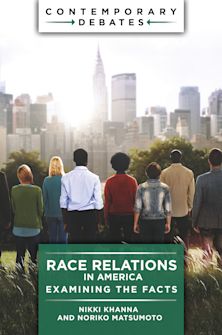- Home
- ACADEMIC
- Sociology
- Sociology of Ethnic and Racial Studies
- South Asians on the U.S. Screen
South Asians on the U.S. Screen
Just Like Everyone Else?
South Asians on the U.S. Screen
Just Like Everyone Else?
This product is usually dispatched within 3 days
- Delivery and returns info
-
Free CA delivery on orders $40 or over
You must sign in to add this item to your wishlist. Please sign in or create an account
Description
How does the media influence society? How do media representations of South Asians, as racial and ethnic minorities, perpetuate stereotypes about this group? How do advancements in visual media, from creative storytelling to streaming technology, inform changing dynamics of all non-white media representations in the 21st century? Analyzing audience perceptions of South Asian characters from The Simpsons, Slumdog Millionaire, Harold and Kumar, The Office, Parks and Recreation, The Big Bang Theory, Outsourced, and many others, Bhoomi K. Thakore argues for the importance of understanding these representations as they influence the positioning of South Asians into the 21st century U.S. racial hierarchy. On one hand, increased acceptance of this group into the entertainment fold has informed audience perceptions of these characters as “just like everyone else.” However, these images remain secondary on the U.S. Screen, and are limited in their ability to break out of traditional stereotypes. As a result, a normative and assimilated white American identity is privileged both on the Screen, and in our increasingly multicultural society.
Table of Contents
Preface: Just Like No One Else
Introduction: South Asians in 21st Century U.S. Television and Film
Chapter 1: Seeing is Believing: A Brief History of Non-Whites Representation in U.S. Television and Film
Chapter 2: A Snapshot of South Asian Characters in U.S. Media (2010)
Chapter 3: Three Degrees of Ethnicity: Racialized Representations of South Asians
Chapter 4: The More Things Change, the More They Stay the Same: Representations of Gender, Ethnicity, and Nationality
Chapter 5: What's the Matter with Outsourced?
Conclusion: The Future of South Asians on the U.S. Screen
Appendix A: Research Methods and Data
Appendix B: Survey Questions
Appendix C: Interview Questions
Product details
| Published | Mar 23 2018 |
|---|---|
| Format | Paperback |
| Edition | 1st |
| Extent | 178 |
| ISBN | 9781498506588 |
| Imprint | Lexington Books |
| Illustrations | 8 b/w illustrations; 3 tables; |
| Dimensions | 230 x 152 mm |
| Publisher | Bloomsbury Publishing |
About the contributors
Reviews
-
Thakore (Elmhurst College) is a sociologist, and in this book she is concerned with cultural appropriation (a term recently made current by novelist Lionel Schriver) and cultural misappropriation. Many scholars have accepted the inevitability of globalization, but others have pitched a culture war against appropriation. Thakore is on the side of the latter. First, she argues, South Asians are underrepresented. Then, when they are represented, they are stereotyped (as in the case of Slumdog Millionaire). In addition to being stereotyped, these characters are rarely three dimensional. Though Thakore comes down hard, she does not overlook work that achieves limited success. Kal Penn’s character in the television series House committed suicide but that was to free Penn up to take a job with the Obama administration. In the end, Thakore contends, in presenting South Asian characters the screen offers them not as multidimensional but as assimilated white Americans—"just like everyone else"—the current trend toward globalization notwithstanding. Thakore uses graphs and survey reports to illustrate her argument. Of interest for those interested in sociology as well as film studies. Summing Up: Recommended. Upper-division undergraduates through faculty.
Choice Reviews
-
Written in accessible prose, South Asians on the U.S. Screen is an engaging and informative text thatjoins a large body of critical race and media scholarshipon film and television, which monitors the onscreenportrayals of different racial groups andevaluates how audiences make sense of thoseimages. Updating earlier work on Asian portrayals,it provides an analysis of contemporary South Asianimages and draws meaningful comparisons withother racial groups. The book would particularlyinterest television aficionados, as well as citizensconcerned with the broader impact of immigrationon facets of everyday life, including the productionand reception of popular film and television images.
Sociology of Race and Ethnicity
-
Racialized representations in the U.S. media are not limited to ‘black and white,’ but incorporate all non-white groups. One group seldom studied as subject to racialized representations is South Asians. In South Asians on the U.S. Screen, Bhoomi K. Thakore uses data from media audiences on South Asian characters and actors and convincingly shows that most of their representations, even the ones deemed by many as “progressive,” privilege white identity thus reproduce white supremacy at the semiotic level.
Eduardo Bonilla-Silva, Duke University; author of Racism Without Racists
-
Through analysis of popular South Asian characters on television as well as the responses of viewers to these representations, South Asians on the US Screen offers insights into the stereotypes that organize media portrayals of South Asians. The book will be of interest to those who want a better understanding of the role played by the US media in the marginalization of racial minorities.
Nazli Kibria, Boston University
-
This book is a fresh and analytically incisive addition to the burgeoning sociological scholarship on racial representations in the mass media. A rich mixed-methods investigation of the historic and contemporary role of South Asians (e.g., Indians) and their representations within the American mass media, Thakore’s book is an important intervention in this growing body of literature for both empirical/substantive reasons as well as the potential to develop theoretical understandings of how racial and ethnic representations operate in a colorblind/postracial society still structured by white supremacy.
David L. Brunsma, Virginia Tech
-
This book is an excellent study of the racialization of South Asian Americans. Building on the work of scholars who have documented South Asian Americans' experience with racism, this book breaks new ground by looking specifically at South Asian Americans on US screens in the 21st century. Dr. Thakore shows how depictions of South Asian Americans are used to uphold contemporary race boundaries, while US television and films appear to be inclusive of a diverse group of people . A well-researched, thoughtful book. A must read for people who are interested in understanding racism.
Bandana Purkayastha, University of Connecticut

ONLINE RESOURCES
Bloomsbury Collections
This book is available on Bloomsbury Collections where your library has access.


































